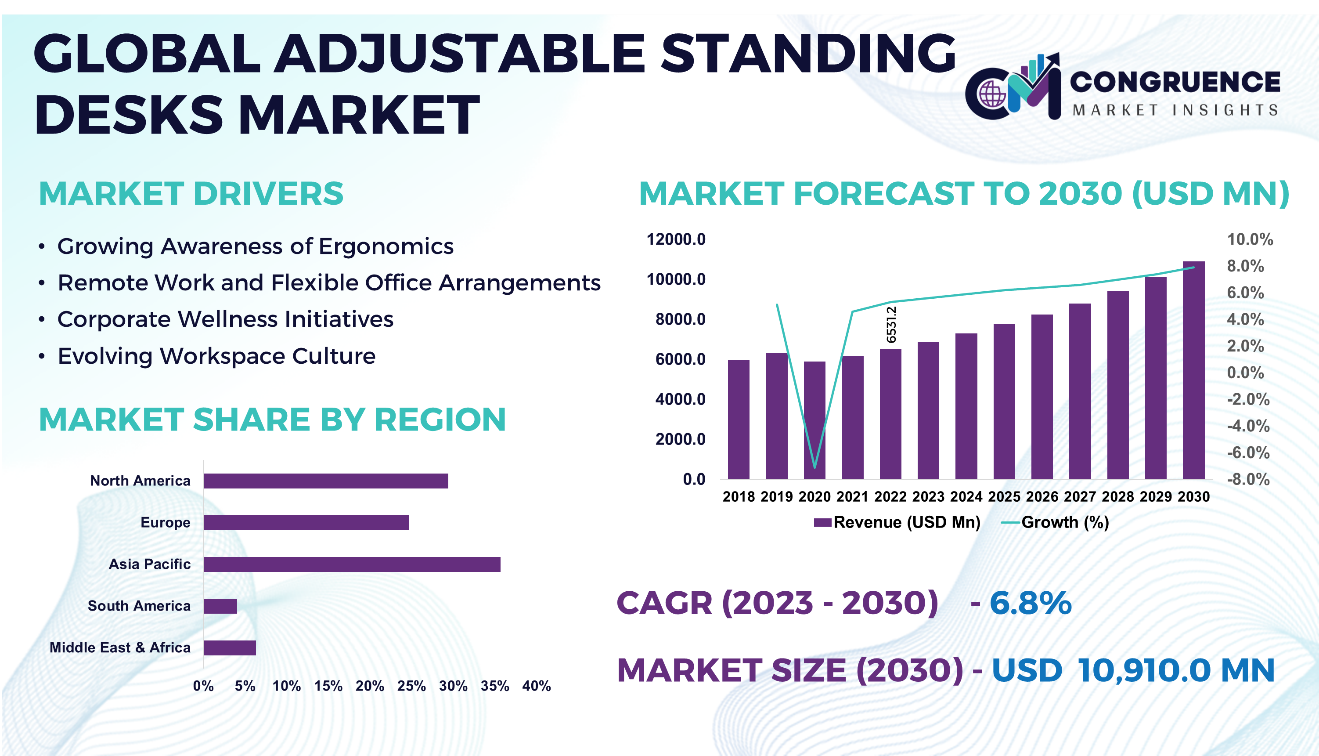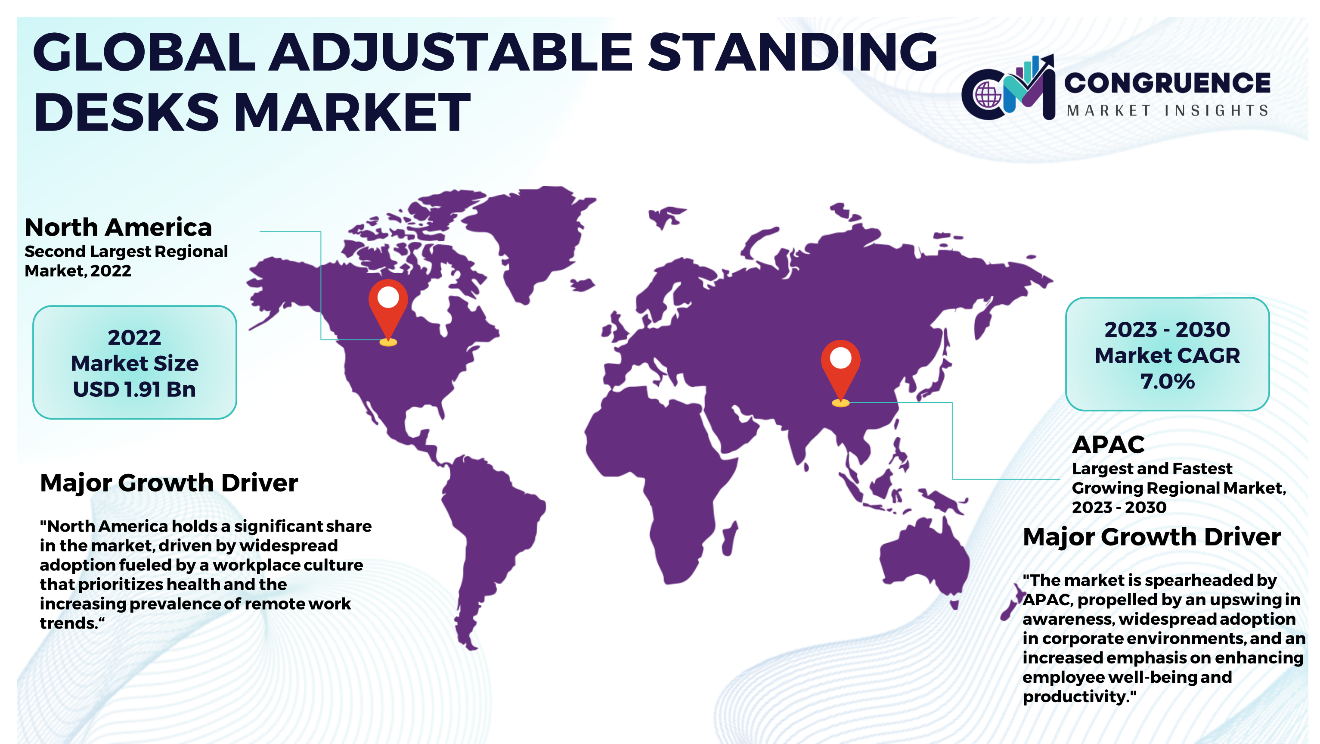Reports
The Global Adjustable Standing Desks Market was valued at USD 6,531.2 Million in 2022 and is anticipated to reach a value of USD 10,910.0 Million by 2030 expanding at a CAGR of 6.8% between 2023 and 2030.
The global market for Adjustable Standing Desks has witnessed substantial growth due to a heightened awareness of ergonomic workspaces and a shift towards healthier work practices. These desks, featuring adjustable height options, facilitate seamless transitions between sitting and standing positions, promoting better posture and potentially enhancing productivity. Key components of these desks include sturdy frames, often made from stability-focused materials like metal, and height-adjustment mechanisms, whether manual or electric. The desktop materials vary, ranging from wood to laminate or glass. Advanced models may incorporate features such as integrated cable management, power outlets, and memory settings tailored to user preferences.
In an era marked by increased remote work and flexible office setups, the importance of adjustable standing desks has grown. These desks address the sedentary nature of desk-centric jobs, offering a solution to mitigate the adverse effects of prolonged sitting. Corporations increasingly recognize the role of ergonomic furniture in enhancing employee well-being, leading to heightened demand in corporate environments. The market landscape includes a mix of established manufacturers and innovative startups catering to diverse consumer needs. Leading companies offer both manual and electric adjustable standing desks, with online channels, including e-commerce platforms, emerging as predominant sales channels. As the market advances, technological progress and a focus on sustainability are expected to shape product development, aligning with the contemporary emphasis on well-being and adaptability in the modern workspace.

Adjustable Standing Desks Market Major Driving Forces
Growing Awareness of Ergonomics: The increasing recognition of the importance of ergonomics in work environments has spurred a demand for adjustable standing desks. Both organizations and individuals acknowledge the impact of ergonomic furniture on health, comfort, and overall productivity.
Remote Work and Flexible Office Arrangements: The surge in remote work and flexible office setups, accelerated by technological advancements, has resulted in an increased demand for adjustable standing desks. Remote workers and organizations are investing in home office solutions that prioritize comfort, flexibility, and the promotion of healthier work habits.
Corporate Wellness Initiatives: Companies are progressively integrating adjustable standing desks into their corporate wellness programs. Providing employees with ergonomic workspaces is viewed as a proactive measure to enhance overall well-being and boost productivity within the corporate setting.
Evolving Workplace Culture: Shifts in workplace culture towards more dynamic and collaborative environments have fueled a growing demand for versatile and adaptable office furniture, with standing desks gaining prominence.
Adjustable Standing Desks Market Key Opportunities
Remote Work Solutions: The surging prevalence of remote work creates a substantial opening for the adjustable standing desks market. With more individuals establishing home offices, the demand for ergonomic furniture, including standing desks, is poised to increase. Manufacturers can seize this expanding segment by providing solutions tailored to the specific needs of remote workers.
Technological Integration: Opportunities abound in integrating advanced technologies into standing desks. Features like smart connectivity, app-controlled height adjustments, and health tracking capabilities have the potential to elevate the user experience. Innovations in technology-driven functionalities can distinguish products in a competitive market.
Sustainability Initiatives: Given the growing focus on sustainable practices, there is an opportunity for manufacturers to develop and market eco-friendly adjustable standing desks. Embracing recycled materials, promoting energy-efficient manufacturing processes, and emphasizing lifecycle sustainability can appeal to environmentally conscious consumers.
Subscription and Leasing Models: Introducing subscription or leasing models for adjustable standing desks offers a flexible and cost-effective option for consumers. This approach can attract budget-conscious individuals and businesses seeking temporary or trial solutions before committing to a purchase.
Adjustable Standing Desks Market Key Trends
· Adjustable standing desks are increasingly integrating smart features like app-controlled height adjustments, connectivity with other devices, and health tracking capabilities.
· Manufacturers are placing a strong emphasis on creating adjustable standing desks with flexible and modular designs.
· The health and ergonomic benefits of standing desks continue to be a prominent trend.
· With the surge in remote work, there is a trend towards integrating adjustable standing desks into home office setups.
· Ongoing innovations in height-adjustment mechanisms, including motorized and pneumatic systems, are impacting the market.
Region-wise Market Insights
Asia Pacific accounted for the largest market share at 35.7% in 2022 and is expected to register the fastest growth, expanding at a CAGR of 7.0% between 2023 and 2030.

Market dynamics for adjustable standing desks vary across regions, reflecting distinct workplace cultures, ergonomic preferences, and technological adoption. In North America, notably the United States and Canada, the adjustable standing desk market has seen significant growth. The increasing trend of remote work, alongside a strong emphasis on employee well-being, has been a driving force. In Europe, countries like Germany and the United Kingdom have steadily embraced ergonomic office solutions, including standing desks, influenced by a proactive approach to workplace health and governmental initiatives promoting ergonomic practices. The Asia-Pacific region, spearheaded by nations such as China and Japan, has witnessed a growing awareness of the health advantages linked to standing desks, with a particular focus on seamlessly integrating these solutions into contemporary office spaces. In emerging markets like Latin America and the Middle East, demand for adjustable standing desks is shaped by a combination of evolving work cultures, the rise of flexible work arrangements, and an increasing acknowledgment of the significance of ergonomic office furniture. Insights into regional markets underscore the adjustable standing desk market's ability to adapt and respond to diverse regional preferences and workplace trends worldwide.
Segment-wise Market Analysis
· Electric Adjustable Standing Desks assert dominance in the market due to their user-friendly and convenient features. The automated height-adjustment mechanism offers seamless transitions between sitting and standing positions, enhancing user experience. With the growing emphasis on ergonomic workspaces, the electric variant gains traction, meeting the demand for effortless and customizable solutions. This dominance is further fueled by technological advancements, providing users with smart connectivity and programmable settings for a personalized and efficient work environment.
· Online stores emerge as the dominant sales channel in the Adjustable Standing Desks market, offering a wide array of products and convenient access for consumers. The digital platform facilitates easy comparison, reviews, and seamless transactions, attracting a substantial customer base. With the surge in e-commerce and the preference for hassle-free shopping experiences, online channels play a pivotal role, influencing purchasing decisions and contributing significantly to the market's growth.
Market Competition Landscape
In the adjustable standing desks market, competition is characterized by a diverse array of players vying for both market share and leadership in innovation. Well-established manufacturers like Steelcase, Herman Miller, and Varidesk stand out prominently, offering a comprehensive range encompassing both manual and electric adjustable standing desks. These industry leaders often establish benchmarks in terms of product quality, ergonomic design, and the integration of cutting-edge technologies. The market has also seen the emergence of innovative startups that introduce novel features and design concepts to meet the evolving demands of consumers. The competitive landscape is further intensified by the presence of both global and regional players, each striving to carve a niche or expand their market presence. Key strategies employed in this competitive environment include differentiating products through advanced features, forming strategic partnerships with health and wellness experts, and an increasing emphasis on sustainable and eco-friendly practices. Online channels, notably e-commerce platforms, have become pivotal arenas for market players, serving as a direct avenue to consumers and influencing purchasing decisions. As the market progresses, the competition landscape is expected to be shaped by continuous technological advancements, a growing emphasis on sustainability, and the ability of players to align with changing consumer preferences in the dynamic realm of ergonomic office furniture.
Key players in the global Adjustable Standing Desks market implement various organic and inorganic strategies to strengthen and improve their market positioning. Prominent players in the market include:
· Steelcase Inc.
· Herman Miller, Inc.
· Haworth Inc.
· Inter IKEA Systems B.V.
· Knoll
· Varidesk, LLC.
· Humanscale
· Ergotron
· Workrite Ergonomics
· Teknion Corporation
· Fellowes Inc.
· Uplift Desk
· Actiforce
· Bretford Manufacturing, Inc.
· MAX-Ability, Inc.
· KontorMøbler A/S
· Kinnarps AB
· TopStar GmbH
· sweetcrispy
· Jin Office Solutions
· Rife Technologies
· TiMOTION Technology Co. Ltd.
· Xdesk.com
|
Report Attribute/Metric |
Details |
|
Market Revenue in 2022 |
USD 6,531.2 Million |
|
Market Revenue in 2030 |
USD 10,910.0 Million |
|
CAGR (2023 – 2030) |
6.8% |
|
Base Year |
2022 |
|
Forecast Period |
2023 – 2030 |
|
Historical Data |
2018 to 2022 |
|
Forecast Unit |
Value (US$ Mn) |
|
Key Report Deliverable |
Revenue Forecast, Growth Trends, Market Dynamics, Segmental Overview, Regional and Country-wise Analysis, Competition Landscape |
|
Segments Covered |
· By Product Type (Manual Adjustable Standing Desks, and Electric Adjustable Standing Desks) · By Material (Metal, Wood, Plastic, and Others) · By Application (Corporate Offices, Residential, Healthcare Facilities, and Institutions) · By Sales Channel (Online Stores, and Offline Stores) |
|
Geographies Covered |
North America: U.S., Canada and Mexico Europe: Germany, France, U.K., Italy, Spain, and Rest of Europe Asia Pacific: China, India, Japan, South Korea, Southeast Asia, and Rest of Asia Pacific South America: Brazil, Argentina, and Rest of Latin America Middle East & Africa: GCC Countries, South Africa, and Rest of Middle East & Africa |
|
Key Players Analyzed |
Steelcase Inc., Herman Miller, Inc., Haworth Inc., Inter IKEA Systems B.V., Knoll, Varidesk, LLC., Humanscale, Ergotron, Workrite Ergonomics, Teknion Corporation, Fellowes Inc., Uplift Desk, Actiforce, Bretford Manufacturing, Inc., MAX-Ability, Inc., KontorMøbler A/S, Kinnarps AB, TopStar GmbH, sweetcrispy, Jin Office Solutions, Rife Technologies, TiMOTION Technology Co. Ltd., and Xdesk.com |
|
Customization & Pricing |
Available on Request (10% Customization is Free) |
